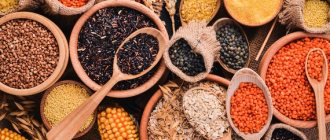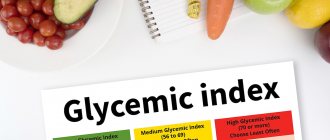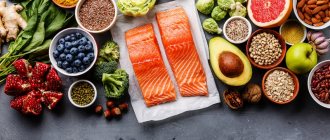Definition of concepts
In the 90s of the 20th century, a full-scale study was conducted aimed at determining the insulin index of products, the relationship between dietary nutrition and the body weight of the subjects.
During the experiments, portions of foods with a calorie content of 240 kcal were taken and compared with white bread. By default, its index is taken as 100% - the reference unit. As a result, the study found that even with the same amount of carbohydrates, there is a difference between the glycemic and insulin indices. In some cases, the insulin index exceeds the glycemic level.
Studies have shown that foods with a low glycemic index can trigger increased insulin production. And this provokes obesity, so you should not use them when losing weight.
You need to understand how the glycemic index differs from insulin. The first indicator reflects the process of insulin synthesis by beta cells: it occurs spasmodically. The production of insulin allows you to reduce the concentration of sugar, but at the same time the fat burning process stops.
The second indicator shows how the insulin content changes when consuming foods. It shows how quickly carbohydrates enter the bloodstream, which bring glucose, which is converted into sugar, and how the pancreas reacts to them. After all, some low-carb foods stimulate increased insulin production.
conclusions
Initially, the theory of the insulin index was studied to find the most suitable way to treat people suffering from diabetes. Research results (Kristine Bell, September 2014) showed that AI-based nutrition for type 1 diabetes patients produced better results than classic carbohydrate counting. The same story happened with subjects with type 2 diabetes who stabilized their blood glucose levels simply by choosing foods that triggered a low insulin response.
| It is assumed that most of the recommendations are also suitable for healthy people who want to reduce body weight due to adipose tissue. |
Using AI in diet planning can help build a healthy menu, but is not a necessary tool. There is logic in the theory about AI, because insulin is an anabolic hormone, and it is not for nothing that bodybuilders use it for muscle growth, increasing the level of insulin in the blood by consuming protein foods mixed with carbohydrates.
It would seem that a well-proven theory is the key to insulin surges, and therefore to slimness. However, in healthy people, the use of a nutrition system based on the control of the insulin index has so far been very little studied, and there is no evidence of the effectiveness of this approach for weight loss.
At the same time, any system that is not harmful to health is worthy of individual research - you can try to take into account AI in creating a diet if you want to try something new, you need to overcome a plateau, or just out of curiosity. To conduct your own experiment, you will need a food insulin index table (for example, this one). Choose products with a low score, analyze the sensations and results - the only meaningful conclusions for you.
Remember that every body is individual. In addition to countless smart indices, such as AI, GI and others, there are many additional factors that can affect blood glucose and insulin levels: genetics, body mass index (BMI), physical activity, daily macronutrient intake, bad habits, microflora intestines and many others. This is confirmed by many studies - we touched on the topic in the article “About the future in nutrition science, or why you should still trust yourself.” It makes sense to conduct your own research, studying and listening to your body, and not immediately take on all the tools and new discoveries of scientists.
Author: Daria Kiseleva, MEng, sports nutritionist, personal fitness trainer
Literature: 1. Glycemic index and glycemic load for 100+ foods. 2. Volkov N.I., Nesen E.N. Biochemical foundations of the life activity of the human body. b.m. : Mir, 2000. 3. N., Barnard. Breaking the Food Seduction. New York: St. Martin's Press, 2003. 4. An insulin index of foods: the insulin demand generated by 1000-kJ portions of common foods. Holt SHA, Brand Miller JC, Petocz P. December 1997, American Journal of Clinical Nutrition. 5. Food insulin index: physiological basis for predicting insulin demand evoked by composite meals. Bao J., De Jong V., Atkinson F., Petocz P., Brand-Miller J. 90, b.m. : American Journal of Clinical Nutrition, 2009. 986–92. 6. Efficacy of carbohydrate counting in type 1 diabetes: a systematic review and meta-analysis. Bell K., Barclay A., Petocz P., Colagiuri S., Bran-Miller JC 133-140, b.m. : Lancet Diabetes and Endocrinology, 2014. 7. Thesis: Clinical application of the food insulin index to diabetes mellitus. K., Bell. Sydney: University of Sydney, School of Molecular and Microbial Bioscience, 2004. 8. Optimizing nutrition, managing insulin. Kendall, Marty. 2015 9. Thesis: Clinical application of the food insulin index to diabetes mellitus. K., Bell. b.m. : University of Sydney, School of Molecular and Microbial Bioscience, 2004. 10. G., Osipov. An invisible organ is the human microflora. Aesthetic medicine. 11. Sisson, Mark. Reader Response: Insulin Index. 12. Zeevi, David et al (2015) Personalized Nutrition by Prediction of Glycemic Responses Cell, 163 (5): 1079 – 1094. 13. Schafer E. The Endocrine Organs. London: Longman, Green & Co., 1916. 14. Sichieri R, Moura AS, Genelhu V, Hu F, Willett WC. An 18-mo randomized trial of a low-glycemic-index diet and weight change in Brazilian women: Am J Clin Nutr. 2007 Sep; 86(3): 707-13. 15. RHR: Is the Glycemic Index Useful?, Chris Kresser 16. INSULIN: AN UNDESERVED BAD REPUTATION, PART 3…MOOOOO!!!!
Menu
An approximate healthy menu for high insulin levels:
- Breakfast: oatmeal with water without sugar, half a glass of seasonal or thawed berries, 150 g of cottage cheese.
- Second breakfast: Citrus fruit.
- Lunch: 120-150 g of lean meat or sea fish, vegetable salad, use olive or linseed oil for dressing.
- Afternoon snack: Green apple.
- Dinner: 120-150 g of stewed meat or fish, a portion of vegetables, olive or flaxseed oil for dressing, parsley, dill, celery or lettuce, a portion of brown or brown rice.
- Second dinner: 30-50 grams of almonds, walnuts.
Interesting article: Foods that lower blood sugar
Menu for low insulin:
- Breakfast: soft-boiled egg, carrot cutlets.
- Second breakfast: porridge with water, bread, dried fruit compote without sugar.
- Lunch: vegetable soup, 120-150 g of lean meat, bread.
- Afternoon snack: yogurt without sugar or fillers.
- Dinner: cottage cheese casserole with candied fruits, green tea with low-fat milk.
- Second dinner: kefir.
Interesting article: Blood glucose levels: normal after meals and foods that lower and increase readings
- Endogenous insulin
Newspaper "News of Medicine and Pharmacy" 11-12 (371-372) 2011
The speed and intensity of the unwanted rapid increase in blood sugar depends on the presence and type of easily digestible carbohydrates in foods. But how to assess the presence and level of such carbohydrates in a food product? Indeed, in reference tables, and in the accompanying information on product packaging, only the total carbohydrate content is usually indicated. For the body, it is not at all indifferent to which products will satisfy the need for carbohydrates. For example, the same amount of carbohydrates can be obtained from both the corresponding portions of buckwheat porridge and honey. But the behavior of these products during digestion differs significantly. In the first case, carbohydrates are absorbed gradually; after eating, blood sugar rises relatively slowly, without causing peak hyperglycemia, without creating an excessive load on the pancreas and the need for large amounts of insulin. The situation is different in the case of a serving of honey (or other sugar-containing product), which will contain the same amount of carbohydrates as a serving of buckwheat porridge. The carbohydrates in honey are easily digestible; they are quickly absorbed and cause an unwanted rapid (peak) rise in blood glucose levels. That is why there was a need to have such an objective criterion that would allow the consumer to know how a particular product affects the rate of rise in blood glucose levels, how suitable this product is for people who must refrain from consuming easily digestible carbohydrates and avoid sharp postprandial (after taking food) hyperglycemia.
An indicator called the “glycemic index” (GI) has been proposed and is widely used as such a criterion. The value of this index indicates whether or not a given product has the ability to cause a rapid (peak) rise in blood glucose levels after its administration. It was agreed that the glycemic index (sometimes called the glycemic factor) of 100 g of glucose is equal to 100 conventional “glycemic” units, respectively, the same indicator of 1 g of glucose is equal to one.
The index value for a particular product was determined through special scientific research. They consist in the fact that the blood glucose level of the tested volunteers is determined every 15 minutes for 2 hours after eating a meal (product), the amount of carbohydrates in which is the same as in the reference dose of glucose (usually 50 g). The peak blood glucose level after taking the reference dose is taken as 100%. Similarly, peak blood glucose levels are determined after consuming various foods. So, for baked potatoes it turned out to be 85%, for pasta - 42%, for cabbage - 10%, for milk chocolate - 70%, honey - 85%, buckwheat porridge - 45%, etc. Similar indicators are used to assess the GI of other products. If the peak blood glucose level after taking this product was, for example, 60%, then the digital GI value for 100 g of this product will be the same, i.e. its GI will be 60.
To facilitate the preparation of a diet, we attach information on the glycemic index value of the most common foods containing carbohydrates (Table 1).
Do not be surprised if you find that in other similar tables the GI indicators of some foods will be slightly different than in the table. 1. Such a difference may be due to modifications of research methods, the nature of the culinary processing of the product, its origin, variety, etc. But usually the differences in GI values are insignificant and do not have significant practical significance.
The research results were reviewed and approved by many authoritative international and regional organizations. In particular, the World Health Organization (WHO), the Food and Agricultural Organization (FAO), the European Association for the Study of Diabetes (EASD), the Australian National Health and Medical Research Council (NHMRS) and others. According to their recommendations, the following criteria for evaluating food products according to the glycemic index and acceptable levels of consumption of these products have been adopted.
Products with a low glycemic index include those whose GI does not exceed 55, medium - with a GI from 56 to 69, foods with a high glycemic index are those whose GI exceeds 70 (remember that the GI of glucose is 100).
In particular, foods with a low glycemic index include: peas, oatmeal, rye bread, dairy products, wholemeal pasta, most fresh fruits, dark chocolate, natural fruit juice without added sugar, green vegetables, tomatoes, lemons, mushrooms, tangerines, grapefruit, broccoli, etc.
For the practical application of information about the glycemic index of certain products when compiling a nutrition menu, it is very important to understand another indicator associated with this index. We are talking about the so-called glycemic load (Glycemic Load - GL). This indicator allows us to judge the actual level of glycemic load when consuming a specific amount of carbohydrates in a serving of a particular dish and in the entire daily diet as a whole.
Let us explain the meaning of the glycemic load index and its calculation using the following example. Let's assume that we want to use 30 g of white rice to prepare a dish (porridge). What will be the actual carbohydrate load of this dish? Following simple arithmetic rules, we calculate that if the glycemic index of 100 g of white rice is 70, then the carbohydrate load (GL) when using 30 g will be 21 (30 ´ 70 : 100 = 21). The carbohydrate load of any other carbohydrate product is calculated in the same way. That is, we multiply the specific carbohydrate content in a serving intended for use by the glycemic index value of this product and divide the result of the multiplication by 100.
In dietetics, the following scale of glycemic load levels of individual portions (meals, dishes) of food is accepted: GL up to 10 is considered low, average - from 11 to 19, high - more than 20.
Knowing what the GI of the original products is and the glycemic load index of the actual diet, you can evaluate and adjust the overall level and tolerance of the glycemic load per day. The usual total daily food load on the glycemic index varies widely, on average between 60 and 180. A total glycemic load (GL) level of not exceeding 80 is considered low, average is from 81 to 119, high is 120 or more.
People who are overweight, have diabetes, as well as some other diseases and conditions that require a dietary diet that limits the amount of carbohydrates consumed should formulate their daily diet so that its total glycemic index does not exceed 80–100.
The essence of the GI diet is to, based on the above criteria and indicators and without disturbing the balance of the contents of all foods, to maximally replace carbohydrate foods that cause a rapid rise in blood sugar levels with those that have a low glycemic index. Those who adhere to such a diet maintain the recommended general biological nutritional value and at the same time create optimal metabolic conditions for the body, do not overload the hormonal apparatus, promote weight loss, prevent excess cholesterol formation, etc. This diet is becoming increasingly popular and in comparison with many other newfangled diets are rightfully considered by most experts to be the most physiological and effective.
Among many others, the glycemic index diet has gained wide popularity and practical application. Nutritionists, not without reason, characterize it as the most appropriate type of low-calorie, low-carbohydrate diet, which has many positive therapeutic and preventive properties. In connection with this diet, a relatively new indicator has recently been increasingly mentioned in the specialized and popular literature - the insulin index of food products (AI). How does it differ from glycemic, what are the needs and recommendations for its use?
It is well known that the intake and assimilation of food is accompanied by a rise in blood sugar (glucose) levels, the so-called postprandial glycemia. Rapid, peak glycemia is undesirable, because helps to weaken the function of the insulin-producing beta cells of the pancreas; the body (especially in diabetes mellitus) with a lack of insulin cannot fully absorb glucose and prevent the main danger of the disease - prolonged high levels of undigested glucose and its compounds in the blood. Since this danger is associated with the consumption of primarily carbohydrate-containing foods, it is very important to limit those that cause peak increases in glycemia. It turned out that even carbohydrate-containing products of the same weight and calorie content behave differently as stimulants of postprandial glycemia: some are capable of causing a rapid and higher level of glycemia, some are more moderate and smooth (i.e., safer for the body) glycemia. To quantify the differences in this property of foods, their glycemic index has been proposed and is widely used.
However, when assessing the biological and nutritional properties of various products, it is necessary to know not only the postprandial glycemia they cause, but also the load experienced by the body to produce (consume) the insulin necessary for the absorption of this product. Since 1997, scientific research has been carried out on this problem. A significant contribution to them also belongs to scientists from the Department of Biochemistry at the University of Sydney.
The purpose of one of the latest studies by these scientists (Am. J. Clin. Nutr. - 2009. - 90. - 986-992) was to compare postprandial insulinemia in response to a food load with an isoenergetic value of 240 kcal. The subjects were offered food that included 38 different foods (fruits, foods rich in carbohydrates and proteins, etc.). Primary studies were carried out by parallel determination of glycemic and insulin indices. Blood samples for analysis were taken every 15 minutes for 2 hours. White bread was used as the initial standard for comparison (its insulin index was taken as 100%). Studies have shown that after eating a carbohydrate meal, increases in blood sugar and insulin levels tended to be strongly correlated (pairwise correlation coefficients were 0.75 or higher).
Here are the comparative values of glycemic and insulin (in parentheses) indices of some food products and products: oatmeal - 60 (40), white flour pasta - 46 (40), white rice - 110 (79), brown rice - 104 (79 ), rye bread - 60 (56), white bread - 100 (100), potatoes - 141 (121), eggs - 42 (31), beef - 21 (51), fish - 28 (59), apples - 50 ( 59), oranges - 39 (60), bananas - 79 (81), grapes - 74 (82), ice cream - 70 (89), Mars bars - 79 (112), yogurt - 62 (115), milk - 30 (90), muesli - 60 (40), corn flakes - 76 (75).
From the above data it is clear that although in most cases there is a proportional relationship between the insulin and glycemic indices of foods (the higher the glycemic index, the higher the insulin index, and vice versa), such a dependence is not obligatory for all products. It has been found that foods rich in protein and containing carbohydrate fats have an insulin index (response) disproportionately higher than the glycemic index of these foods.
Interpretation of such a response is difficult. On the one hand, the positive thing is that increased insulin levels contribute to lower levels of postprandial glycemia. However, the downside is that to achieve this effect, the body will contribute to the depletion of pancreatic beta cells and the development of type 2 diabetes.
The disproportionate increase in AI has its own explanations. According to S. Holt and her co-authors, this is due to the fact that insulin helps digestion of food not only in terms of the absorption of carbohydrates. It is needed for amino acids in muscle cells involved in the process of carbohydrate absorption. Increased insulin is also needed because when protein foods are consumed, glucagon is released from the liver, which increases blood sugar levels. For healthy people this is not a problem. The picture is different in diabetes, when the physiological mechanism of compensation is disrupted and it is much more difficult for the body to compensate for glycemia, because he is also forced to cope with an additional carbohydrate load caused by the release of glucagon from the liver under the influence of protein foods.
According to the level of AI, food products are divided into three groups:
1) having high AI. These include bread, milk, yogurt, confectionery, potatoes, breakfast cereals;
2) products with a moderately high (average) level of AI - beef, fish;
3) products with low AI - eggs, buckwheat, oatmeal, muesli.
From the above, an important conclusion for dietetics follows: when consuming certain protein foods with a low glycemic index (for example, beef) to achieve relatively low glycemia, the insulin release may be disproportionately higher than when consuming most carbohydrate foods.
Knowledge of the insulin index of foods is of great importance when eating a mixed diet for people using an insulin pump, because allows you to more accurately predict the need for insulin. It is necessary to take into account not only the content of carbohydrates in food, but also their energy value. With the same carbohydrate content, the energy value of foods due to proteins and fats is higher, and this, in turn, determines the need for higher insulinemia.
It follows from this that only the glycemic index of foods does not always characterize the need for insulin necessary for their absorption and the load on its secretion by the beta cells of the pancreas. This observation has very important practical significance, because allows you to more correctly regulate insulin therapy for diabetes. In addition, foods with equal carbohydrate content do not necessarily stimulate insulin secretion to the same extent. For example, isoenergetic servings of pasta and potatoes contained ~50 g carbohydrates, but the GL for potatoes was three times that of pasta.
It is fair to note that one of the leading experts on the problem of the insulin index, D. Miller from the University of Sydney, points out that “although the insulin index looks promising, it should be emphasized that it will never replace the GI. And AI has the greatest promise in correcting glycemia for people with type 1 diabetes using pumps.”
Further research into this problem is needed, but today the glycemic index is undoubtedly the optimal criterion for predicting the glycemic load of foods on the body.
Table
Products containing insulin index (II) are divided into three categories.
These categories are: low AI content (buckwheat, eggs, oats), medium AI content (lean meat, any fish), high AI content (milk, potatoes, baked goods and unnatural yoghurts).
| Name | AI content |
| sucking candy | 160 |
| Chocolate bars “Mars”, “Snickers”, etc. | 122 |
| Potato | 121 |
| Canned beans | 120 |
| Yogurt with fillings | 115 |
| Dates | 110 |
| Beer drinks | 108 |
| White or gray bread | 100 |
| Sour milk | 98 |
| Black bread | 96 |
| Cracker | 92 |
| Cow's milk | 90 |
| Ice cream | 89 |
| Cupcakes, pastries, grapes, watermelon | 82 |
| Bananas | 81 |
| Boiled rice | 79 |
| Corn | 75 |
| Donuts, French fries | 74 |
| Brown, red, brown rice | 62 |
| Chips | 61 |
| Oranges | 60 |
| Seafood, apples | 59 |
| Yeast-free bread | 56 |
| Popcorn | 54 |
| Beef, veal | 51 |
| Products with added lactose | 50 |
| Cheeses | 45 |
| Pasta | 40 |
| Chicken eggs | 31 |
| Grapefruit, cherry, pearl barley, lentils of any variety, natural chocolate | 22 |
| Peanuts, apricots, legumes | 20 |
| Broccoli and regular cabbage, boiled mushrooms, onions, peppers, eggplants, tomatoes, lettuce | 10 |
| Sunflower seed | 8 |
Interesting article: Proper diet and treatment of diabetes mellitus type 1 and 2
Insulin food index - tables
Note that the insulin index tables contain only average values that can vary up to 30% depending on a number of factors. First of all, the presence of food in the stomach influences - as well as the combination of foods consumed. Plus, a person’s physical form also affects insulin production.
For ease of use, the insulin index is calculated using a serving containing 240 kcal - while the glycemic index is determined for a serving containing 50 g of net carbohydrates². That is, although the final volume of the product may be the same size, it may be different.
How are indicators calculated?
The benchmark is 100%. As a basis, a professor from Australia took the insulin surge recorded after eating a piece of white bread with an energy value of 240 kcal. In the studies, servings of other foods also had their caloric content listed.
During testing, patients consumed one of the names, then, at intervals of 15 minutes, for two hours, doctors took blood samples to clarify the values of glucose and insulin in the blood. In most cases, products with a GI of 60 units or more also had AI indicators above average, but there were exceptions: fish, cottage cheese, meat, natural yogurt.
Practical application of GI and AI
The general recommendation for everyone except insulin-dependent diabetics is that when comparing two parameters, you need to focus more on GI, and then adapt your diet to AI and other parameters. But you shouldn’t neglect AI either - increased insulin production depletes the insulin gland, giving the command to accumulate fat rather than using the reserves of what is already available.
Preventing high sugar levels
To prevent problems with sugar levels in the body, certain rules should be followed:
- Play sports, walk a lot, spend active recreation.
- Know your optimal weight and try not to exceed it.
- Monitor blood pressure, eat food without salt or other harmful ingredients.
- Treat various diseases in a timely manner.
- Refrain from drinking alcohol.
- Stick to proper nutrition and try to eat healthy foods.
- Take preventive vitamin and mineral complexes.
- Monitor blood sugar levels and take timely measures if levels are elevated.
Signs of diabetes
Problems with high, indigestible sugar can be prevented in the early stages. To do this, you need to know the signs of the disease. If you identify it in time and don’t let it get to a neglected state, you can quickly improve your health and not lead to serious problems. List of signs characteristic of patients with diabetes:
- Poor eyesight.
- Loss of concentration.
- Headache.
- Fainting.
- Heart pain.
- Leg problems (pain, loss of sensation).
- Poor healing of the skin after damage.
- Swelling on the face and legs.
- Enlarged liver.
- Loss of sensitivity in the skin on the hands.
- High pressure.
Health problems can be avoided by watching the food you eat. Foods that have a high insulin index should be avoided. People prone to high sugar content will have to constantly create their menu of edibles with a little AI. It is necessary to adhere to diets, rules of fractional or light meals. You need to treat your health with care, then the body will respond with gratitude to such treatment and will not be bothered by a large number of diseases.
Insulin and its role in our body
Insulin is one of the key hormones.
- In the human body, its function is to serve as a conductor for glucose coming from food.
- It helps this substance be delivered to cells, where it begins to be converted and used as an energy source.
When insulin production is insufficient.
In this situation, the body is unable to absorb substances such as carbohydrates from foods. This negative process can lead to the accumulation of excess sugar in the blood. In medicine, this pathological condition is usually called type 1 diabetes. When making such a diagnosis, a deficiency of your own insulin requires correction with special injections containing this hormone.
When the body refuses to use insulin.
There is another disease called “type 2 diabetes.” This disease is caused by the fact that the human body generally refuses to use insulin, although it can be produced in normal quantities. One of the factors responsible for the development of diabetes is an incorrect diet, in which people regularly and too much consume foods rich in fast carbohydrates. Such a diagnosis is associated with the appearance of overweight and obesity, as well as the development against the background of a whole list of unpleasant and dangerous diseases.
How to use index values in practice?
Now we will tell you how and why to take into account the insulin index of foods along with the glycemic index on a diet. For those diagnosed with diabetes, it is necessary to start planning your nutrition program with the glycemic index. Only after this should the selected products be adjusted to one another using the insulin index.
In no case should you ignore the insulin index, since foods with high values can deplete the pancreas in a short time. As a result, lipids will accumulate rather than using existing reserves.
How to combine products:
- Products containing protein compounds should not be combined with simple carbohydrates and starch products.
- Starch is incompatible with simple carbohydrates, but can be consumed with fats.
- Vegetables, starch and protein are not combined with simple carbohydrates, but only with fats.
- Vegetables should be consumed together with fats and protein compounds, but not simple carbohydrates.
Based on the above, the following recommendations can be given to people suffering from diabetes:
- Do not consume fast carbohydrates with fats, for example, meat should not be washed down with sweet drinks.
- Try to avoid combining protein and carbohydrates - it is better not to add honey to cottage cheese.
- An excellent combination is unsaturated fats and complex carbohydrates - nuts and fish.
- Try not to subject foods to prolonged heat treatment.
- For breakfast, eat foods rich in protein compounds.
- Complex carbohydrates should be consumed in the evening, as they do not cause a sharp release of insulin.
If you need to lose weight, then foods with a high insulin index should be consumed in the first half of the day. Somewhere after 14 hours they should be abandoned so as not to cause a sharp surge in insulin concentration. Sometimes a person needs not to lose weight, but to gain it.
To solve this problem, you can also manipulate the AI indicator of various products. You need to divide them into three doses and consume them as follows:
- Before lunch - two doses.
- After lunch - one dose.
It should be recognized that the situation with the glycemic and insulin index is ambiguous and a nutritionist will help you understand this issue in detail.
So, let's figure out how the insulin index of cottage cheese affects the amount of sugar in the bloodstream and weight loss. The GI of cottage cheese is low - 30, but the AI of cottage cheese is 120, one cannot help but notice this stunning difference.
Despite the fact that cottage cheese products do not provoke an increase in sugar levels, the pancreas reacts to the entry of cottage cheese into the body and immediately releases insulin. A high amount of the hormone gives a command to the body about the reserves of adipose tissue and does not allow it to burn the incoming fat, since lipase, the main fat burner, is blocked.
Even though the GI is reduced, because the AI is high, the body does not burn fat.
It is recommended to eat protein foods with carbohydrates to reduce the GI level, but this does not always stimulate the insulin response.
If cottage cheese or dairy products are added to foods with a low GI, their glycemic index will become high. Therefore, if you like to eat oatmeal with milk for your first breakfast, you need to understand that its calorie content will increase sharply, as insulin jumps, GI and AI are increased, and adipose tissue increases.
I wrote above that the main use of the index is to better calculate the dose of insulin for injection after meals. But the insulin response is largely individual and not fully understood. Therefore, focus more on the glycemic index.
For people who do not need inulin injections, the insulin index can help create a more balanced diet to avoid large insulin spikes. During the surge, the liver releases all glucagon and remains “empty”. It begins to signal this to the body, causing a sharp feeling of hunger. A person eats, which subsequently leads to weight gain, metabolic syndrome and increased tissue insulin resistance.
Also, with high insulin production, the production of lipase, which is involved in “fat burning,” is blocked. Thus, fats are stored in the body, increasing fat mass and insulin resistance of tissues.
Basics of a diet based on the insulin index
The best practice for using AI tables for diabetic nutrition is the following rules:
- Don't snack on dairy products. This will cause a surge in insulin and further increase the feeling of hunger.
- Do not combine high AI foods with fatty foods. For example, do not season boiled potatoes with yogurt. Don't eat beans with pork.
- Try to exclude as much as possible foods that have both a high insulin index and a high glycemic index.
- Beer, which has a high index, do not snack on fatty snacks.
- Eat foods with a high insulin index in the first half of the day. In the evening, give preference to vegetables and fish. In addition to low AI, they have a low glycemic index.
- Do not combine high-index, low-carbohydrate foods (such as milk) with other low-carb foods. This will cause an excess of insulin and increased hunger. If you decide to drink, for example, milk, wash down your porridge with it. But, for example, brown rice already has enough carbohydrates. Therefore, it is better to eat it with vegetables.
What is important to remember about the insulin index of products?
It is quite clear that it is impossible to determine the insulin index yourself and you will have to use special tables. However, complete information on this issue is not freely available, and those tables that “wander” on the Internet in most cases contain some inaccuracies. First of all, you should remember the most important points:
- The insulin index of dairy products is high.
- Meat and fish dishes have AI from 45 to 60 units.
- Raw chicken eggs have a low AI of 31.
- The group with a low insulin index includes vegetables, except potatoes and mushrooms.
- The insulin index of dark chocolate and fruit ranges from 20 to 22 units.
Products with low AI include apples, beef, eggs, fish, cheese, pasta, oatmeal, etc. Correspondingly, grapes, potatoes, white rice, yogurt, bananas, oranges, etc. have high AI.











